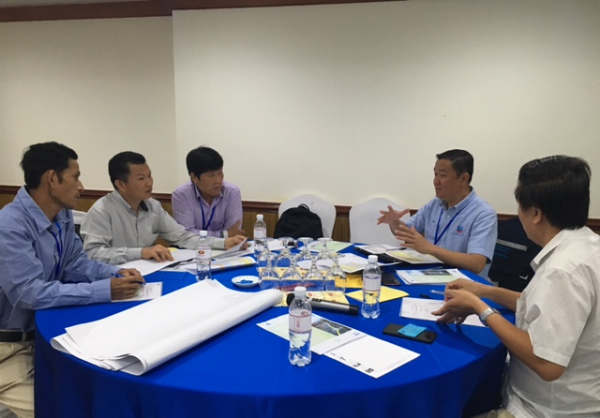Strengthening oil spill response readiness in the Gulf of Thailand
Thursday, 26 March 2020

(Picture c/o the Ministry of Public Works)
The impacts of oil spills, which risk significant harm to ecosystems and coastal communities, mean that dealing with them quickly and effectively is an important task for any country. Marine oil spills, which do not respect boundaries, are challenging events, where a prompt and effective response can greatly alter results.
Given the significance of oil spill response to coastal areas, PEMSEA has long supported the development of capacity and technology regarding mitigation, containment, and cleanup. One area of focus has been the Gulf of Thailand, a shallow large marine ecosystem with little water exchange. This slow water flow combined with increasing maritime activities makes the gulf a high-risk area for oil spills.
As large oil spills may have transboundary impacts, Cambodia, Thailand, and Viet Nam are working together to enhance capacities for preparedness and response for oil spill incidents both at the national and sub-regional level. PEMSEA has been providing technical support to Gulf of Thailand Cooperation since the adoption of Joint Statement by the three countries in 2006.
Last 4-5 February saw this cooperation continue, as the countries came together for the Training Workshop on Oil Spill Response Planning and Readiness Assessment. PEMSEA non-country partners Oil Spill Response Limited (OSRL) and IPIECA—Global Initiative for South East Asia (GISEA) provided resource persons for the workshop.
The two-day workshop was particularly focused on a new tool, the Readiness Evaluation Tool for Oil Spills (RETOS). An overview of the tool was provided (via skype) by Miguel Moyano, Upstream Director of ARPEL, and followed by a detailed discussion and exercises by Nai Ming Lee, IPIECA-GISEA, and Edelina Melisa, OSRL. RETOS was developed by the Regional Association of Oil, Gas, and Biofuels Sector Companies in Latin America and the Caribbean (ARPEL), and can be applied in oil spill capability assessments at local, national, and sub-regional levels. Within the workshop, table-top exercises allowed direct experience with RETOS. These exercises covered key elements of the SOSCP, including mechanisms to activate it, notification arrangements, communication flows, response strategies, requests for spill surveillance, requests for assistance, and reporting. Insight gained from the tool will be used to strengthen national and sub-regional capabilities for oil spill response.
Baseline national capacity in all aspects of oil spill recovery is key to the effective implementation of any of the oil spill contingency plans. Joint training, such as in this workshop, and joint exercises in the field will aid with cooperation between the three countries. Maintaining and enhancing communication is a key part of the sub-regional agreement, and as past cooperation has succeeded in achieving effective levels of operational communication, attention is now being turned to solidifying communication among higher levels of government. Another key lesson from the workshop was the importance of cooperation between government and industry.
Following the workshop, a one day event, the 13th Annual National Contact Points meeting on the implementation of the Framework Programme for Joint Oil Spill Preparedness and Response in the Gulf of Thailand, was hosted by the Cambodian Ministry of Public Works and Transport. This meeting was used for representatives of the three countries to share national initiatives to support the Gulf of Thailand Framework Programme relating to legislation, capacity building activities, and lessons learned from oil spill incidents. Plans for 2020-2021 were presented, and sub-regional efforts were discussed.
Thailand’s current oil spill contingency plan and dispersant use guidelines were updated following the 2013 Rayong oil spill incident. Cambodia’s dispersant use guidelines are in the process of being updated. Viet Nam is developing a national guideline for dispersant usage.
Cambodia is in the process of fast-tracking the updating of its NOSCP, which was delayed by organizational reforms. It is also developing a draft waterway transport law which will impact shipping. Thailand shared that its experience to recent oil spills, Dragon 2 and Golden Bridge 2, has been dealt with effectively through its existing processes. Viet Nam intends to organize a meeting involving Vietnam Search and Rescue Committee (VINASARCOM), Vietnam Administration for Seas and Islands (VASI), and Vietnam Maritime Administration (VINAMARINE) to clarify institutional arrangements relating to oil spill responses.
The three countries have agreed on a Sub-regional Oil Spill Contingency Plan (SOSCP), and are implementing the Gulf of Thailand Strategic Action Plan 2017-2021. The SOSCP has adopted the framework of the ASEAN Regional Oil Spill Contingency Plan (ROSCP) and the most practical approach to operationalizing the ASEAN ROSCP. As part of the sustainability measures of the Gulf of Thailand Cooperation program, it is aimed that Gulf of Thailand Joint Cooperation activities are mainstreamed into the annual budgets of each country.
Further discussions on the sub-regional arrangement for oil spill response in the Gulf of Thailand will occur at PEMSEA’s 2021 7th East Asian Seas Congress.



